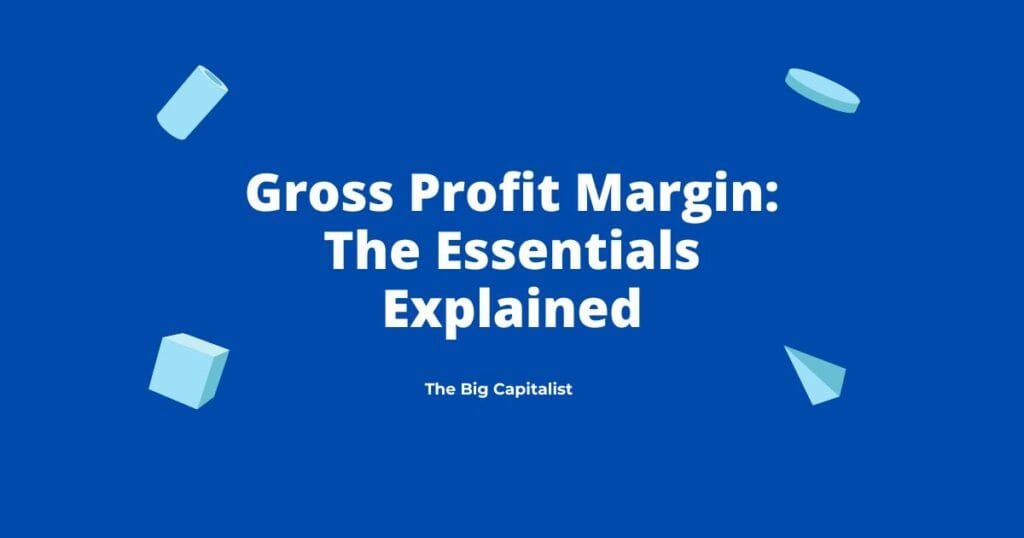Gross profit margin is a financial metric that offers a snapshot of a company’s financial wellbeing and its ability to convert revenue into profit. By revealing the percentage of revenue that exceeds the cost of goods sold (COGS), it provides insight into the efficiency and sustainability of a company’s business model. Expressed as a percentage, the gross profit margin allows businesses to assess their financial success and operational efficiency at a glance.
The Gross Margin Formula
The formula to calculate the gross profit margin is straightforward and easily accessible to anyone with a basic understanding of financial statements:
Gross Profit Margin = [(Revenue – Cost of Goods Sold) / Revenue] * 100
Here’s a quick breakdown of the terms involved:
- Revenue: This is the total amount of money generated from the sales of goods or services. It represents the top line of the income statement, indicating the company’s total earnings before any expenses are deducted.
- Cost of Goods Sold (COGS): These are the direct costs attributable to the production of the goods sold by a company. This includes the cost of materials and labor directly used to create the product, offering a clear picture of the expenses tied directly to product manufacturing.
Why is Gross Profit Margin Important?
Understanding this metric is crucial because it provides insight into how efficiently your business utilizes its resources. A higher margin suggests a more profitable company with better control over costs compared to competitors, reflecting strong competitive advantage and effective cost management—both vital for long-term success.
Moreover, gross margin serves as a foundation for evaluating other financial metrics. It helps business owners and managers identify trends, set benchmarks, and make strategic decisions that align with their financial goals. By regularly monitoring this figure, businesses can pinpoint areas for improvement and take proactive measures to enhance profitability.
How to Calculate the Gross Profit Margin Percentage
To accurately calculate this percentage, gather specific financial data, namely revenue and COGS. Let’s walk through an example to illustrate the calculation process.
Example Calculation
Imagine your company has an annual revenue of $500,000 and a COGS of $300,000. Here’s how you would calculate the gross profit margin:
- Calculate Gross Profit: Subtract COGS from Revenue.Gross Profit = $500,000 – $300,000 = $200,000
- Calculate Gross Profit Margin: Use the gross margin formula.Gross Profit Margin = ($200,000 / $500,000) * 100 = 40%
This calculation indicates that for every dollar your company earns, it retains $0.40 after covering the cost of goods sold. This retained amount is crucial for covering additional expenses and achieving net profitability.
Interpreting the Results
A gross profit margin of 40% is generally considered good, but this can vary significantly by industry. It’s important to compare your margin with industry averages and historical data to get a comprehensive picture. For instance, a 40% margin might be excellent in the manufacturing sector but considered average in the software industry. Therefore, benchmarking against industry standards can provide valuable context and help you set realistic financial goals.
Factors Influencing Gross Profit Margin
Several factors can affect your gross profit margin, and understanding these can help you manage and improve it. Recognizing these variables allows you to take strategic actions that can bolster your margin over time.
Pricing Strategy
Your pricing strategy directly impacts your gross profit margin. Setting prices too low can reduce your margin, while higher prices can improve it. However, it’s crucial to strike a balance that keeps you competitive in the market. An effective pricing strategy involves understanding customer perceptions, market trends, and the competitive landscape to ensure that your prices reflect the value of your offerings without alienating potential customers.
Cost Control
Efficiently managing your production costs is key to maintaining a healthy margin. This includes negotiating better prices with suppliers, reducing waste, and optimizing production processes. Implementing cost control measures requires a thorough analysis of your supply chain, procurement practices, and production workflows to identify inefficiencies and opportunities for savings.
Sales Volume
Higher sales volumes can lead to better economies of scale, which can lower the per-unit cost of goods sold and improve your gross profit margin. By increasing production volumes, businesses can spread fixed costs over a larger number of units, effectively reducing the average cost per unit. Strategic marketing, expanding distribution channels, and enhancing product offerings can all contribute to boosting sales volume.
Improving Your Gross Profit Margin
To improve your gross profit margin, consider implementing the following strategies. These approaches can help you optimize your operations and increase profitability.
Optimize Your Supply Chain
Review your supply chain processes to identify areas where costs can be reduced. This might involve finding new suppliers, renegotiating existing contracts, or streamlining logistics. By enhancing supply chain efficiency, you can lower production costs and improve your gross profit margin, ultimately leading to greater financial stability.
Increase Prices Strategically
If your gross profit margin is low, consider revising your pricing strategy. Make sure to analyze the market to ensure that any price increases do not deter customers. Conduct thorough market research to understand price elasticity and customer sensitivity, enabling you to adjust prices in a way that maximizes revenue without sacrificing customer loyalty.
Enhance Production Efficiency
Invest in technology or training that can help your production team work more efficiently. Reducing waste and improving productivity can lead to cost savings and a better margin. Implementing lean manufacturing principles, upgrading equipment, and fostering a culture of continuous improvement can significantly enhance production efficiency and profitability.
Product Mix Optimization
Evaluate your product line to focus on high-margin items. Sometimes, eliminating or reducing the focus on lower-margin products can improve your overall gross profit margin. Conduct a product profitability analysis to identify which items contribute most to your bottom line and adjust your product mix accordingly to optimize financial performance.
Gross Profit Margin vs. Net Profit Margin
It’s important to distinguish between gross profit margin and net profit margin. While gross profit margin focuses only on the cost of goods sold, net profit margin considers all expenses, including operating costs, taxes, and interest. Both metrics are important, but they serve different purposes in financial analysis. Gross profit margin provides insight into production efficiency, while net profit margin offers a comprehensive view of overall profitability, encompassing all aspects of the business.
Conclusion
Understanding and managing your gross profit margin is vital for the financial success of your business. It helps you assess how well your business is performing and provides insights into areas where you can improve efficiency and profitability. By regularly monitoring this metric and implementing strategies to optimize it, you can ensure your business remains competitive and financially healthy.
Frequently Asked Questions (FAQ)
1. What does gross profit margin tell me?
It shows how much money you keep from sales after covering the direct costs of making your products.
2. How is it calculated?
Use the formula: (Revenue – Cost of Goods Sold) ÷ Revenue × 100 to get the percentage.
3. What affects this percentage?
Pricing, production costs, and sales volume all impact your margin. Efficient operations and smart pricing improve it.
4. How can I improve my margin?
Streamline your supply chain, raise prices carefully, boost production efficiency, or focus on high-margin products.
















